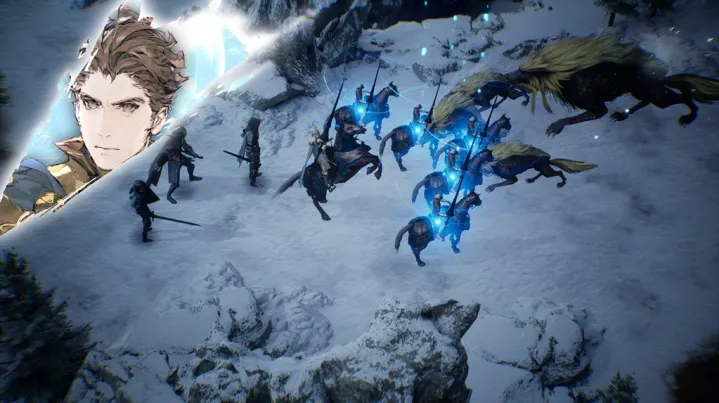Japan isn’t exactly known for real time strategy games. That’s why I was surprised to discover that The DioField Chronicle was a real-time strategy game, and not a turn-based tactics one like the Fire Emblem series. In terms of gameplay, this already sets The DioField Chronicle apart from other similar titles in the genre as Japanese strategy games lean heavily toward turn-based and grid-based tactics.
In a hands-on preview, I played around three hours of The DioField Chronicle, which consisted of the game’s first chapter. I came away impressed by the gameplay as it’s easy to understand for those who aren’t deeply familiar with real-time strategy games already. Though what especially stands out is that it almost feels like a JRPG thanks to over-the-top battles that capture the genre’s love of flashy combat.
Friendly for newcomers
As someone who doesn’t play RTS games often at all, The DioField Chronicle’s gameplay systems are quite beginner-friendly. The game takes a more focused approach to the genre rather than piling on systems. Instead of having tens of units, you can take a party of up to four characters and send them out into the battlefield. You don’t build bases or earn any currency to call in more units. It’s more like managing an RPG party than an army.
While the RTS genre has never been one of my go-tos, I distinctly flashbacked to Halo Wars during my demo. I remember feeling overwhelmed and stressed at all of the different vehicles, units, and bases I had to keep track of in real-time. In The DioField Chronicle, you just have to focus on your party of four (sometimes a fifth unit as well, as one of the beginning missions requires you to escort a defenseless carriage through the battlefield).
Having a fast reaction time and thinking quickly on your feet are helpful skills when playing RTS games, and this focused approach removes some barriers for those who aren’t able to quite match others. Additionally, I felt more connected to my units as characters whereas in other games my troops would be nameless units that I couldn’t care less about dying.

However, what makes battles much more manageable is that using a character’s special skills pauses the action and lets you take your time to decide what to do next. Is one of your teammates low on HP? You won’t have to worry about accidentally selecting the wrong character to heal amidst the chaos of battle.
I played the demo on my PS5 using a controller, so I really appreciated this pause function as it accommodated my slow cursor movement with the left control stick. RTS games are more naturally suited toward PC controls, as utilizing a mouse and keyboard makes for faster response times and navigating the battlefield, so it’s nice to see good controller considerations here.
Glory on the battlefield
Each character has skills to unleash during battle, such as Andrias’ Assassination, where he slices through a single enemy multiple times leaving afterimages of himself. Waltaquin’s Convalescent Circle skill creates a giant area where units within its vicinity recover HP at regular intervals. All of these skills look incredibly flashy, as if they were pulled straight out of a JRPG. Peeking at the skill tree, later unlockable ones seem to have more cinematic angles to them, allowing for more dynamic visuals.
Different colored orbs are littered throughout the battlefield, too: green is HP, blue is EP, and purple is TP. With enough TP built up, players can summon mystical creatures just as they would in a series like Final Fantasy. There’s nothing quite like summoning Bahamut, causing it to swoop into the sky and graze an entire portion of the battlefield with a powerful blast.

Even on the easiest difficulty (Casual), some battles can be quite tough if you rush head-on without a plan. That’s especially true against boss units if you’re under-leveled. At the very last mission in the preview, I faced off against a big Fenrir boss with three of its smaller wolf underlings. I went in with my usual strategy of spamming skills until my enemies were dead, but that didn’t quite work out for me.
I abused Waltaquin’s Convalescent Circle skill at the beginning of the boss fight, her most costly skill. I quickly found myself out of EP, unable to initiate a simple healing spell. I initially relied on Iscarion’s bow skills to do extra damage, but I soon realized I needed to conserve his EP as well for his Stun Shot skill. This allowed me to cancel out the boss’s huge charge-up AOE ice attack that completely wiped my party multiple times.
Although you can’t save during a battle, there are checkpoints that you can reload if you end up losing. For example, there was a checkpoint right before I got into the Fenrir fight, and thankfully, I didn’t have to start the entire mission from the beginning again.
The story is … there
So far, The DioField Chronicle’s Story hasn’t completely grabbed me just yet. The game’s backstory contains quite a bit of jargon, explaining how the DioField island is rich with Jade, a valuable natural resource that sets up the game’s political conflict. Different factions are trying to get their hands on it, so conflict ensues.
Andrias and his companions form the Blue Foxes, a mercenary group that intends to fight back against the Empire. However, a new threat seems to be on the horizon, which might make the story more enticing later on. But only being about three hours in, I wasn’t able to fully grasp the true scope of the narrative yet.
In addition to the game’s main quests, there are sub-quests that focus on specific characters in your party and their backstories. Unfortunately, I wasn’t able to experience any of them yet, as none of them unlocked during the first chapter, but I hope they go in-depth and provide us with some needed character motivations.

So far, The DioField Chronicle’s gameplay leaves a strong impression. Even though I’m only in the first chapter, I can already look at the menus and see the extensive unit customization options, including weapon creation, sub-units, and skill trees. In a rare genre of Japanese real-time strategy RPGs, The DioField Chronicle’s opening hours still have the familiar sense of a JRPG. If the game can keep up with its combat progression, it’ll continue to feel fresh for the entire journey. A great story and a compelling cast of characters will just be icing on the cake.
The DioField Chronicle launches on September 22 for PC, PS4, PS5, Xbox One, Xbox Series X/S, and Nintendo Switch. A demo will be available for players on August 10.



